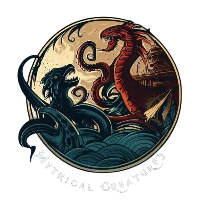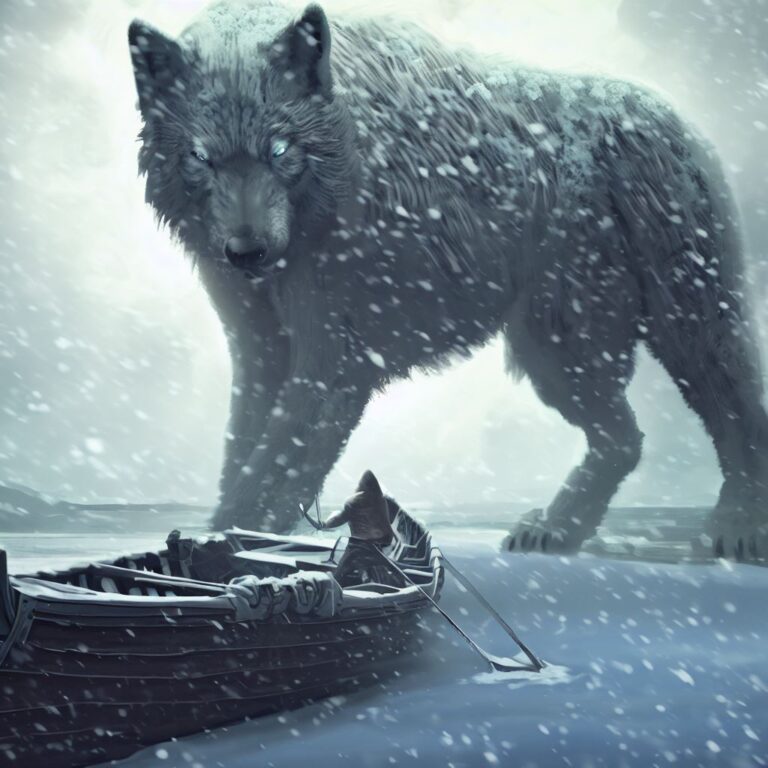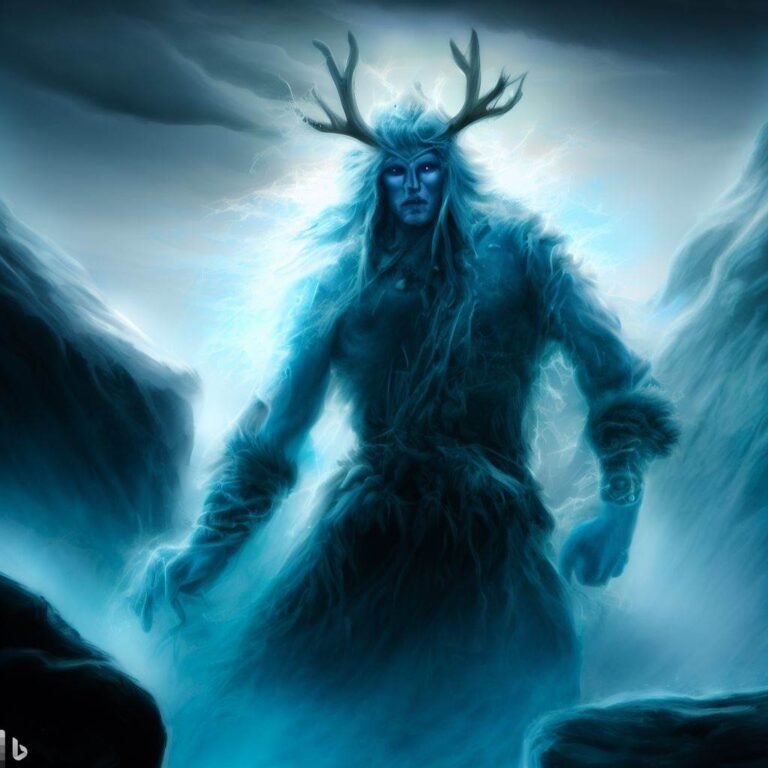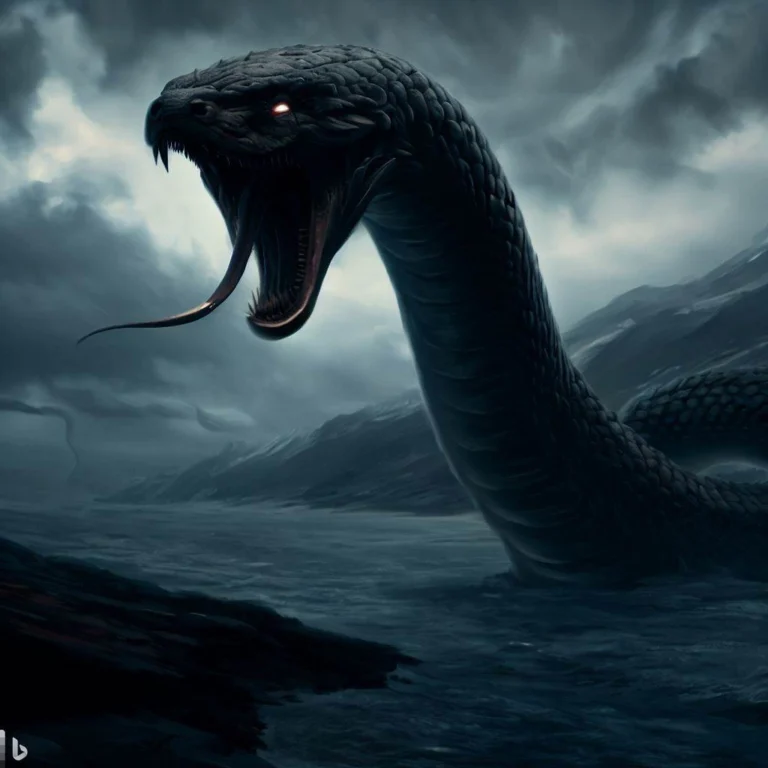![Rán - The Norse Goddess of the Sea [Pics and Facts] 1 mythical creatures art Ran Norse Goddess of the sea Viking gods](https://mythicalcreatures.blog/wp-content/uploads/2023/08/Ran-Norse-Goddess-of-the-sea-Viking-gods.jpg)
Rán is a goddess in Norse mythology who rules over the depths of the ocean. With her net, Rán draws drowned sailors down into her cold embrace.
She is believed to gather the bodies of those perished at sea and take them to her underwater hall.
To Vikings and coastal dwellers, Rán represented the terror and unpredictability of the sea. She was greatly feared by seafarers who made offerings in hopes of avoiding her wrath.
Yet she also personified the sea’s abundance and rewards for those daring enough to travel her domain.
Rán remains an enigmatic figure–revered, dreaded and respected for her vital role in Norse culture and mythology.
Rán’s Origins and Family
Rán is the daughter of the jötunn Ægir, also known as Hlér, a primordial god of the sea. Her mother is also Rán, a sea goddess whose name became synonymous with the sea itself.
As Ægir’s daughter, Rán becomes the personification of storms and perils at sea.
Rán marries Ægir and together they have nine daughters, representing the characteristics of ocean waves.
Their daughters’ names are Himinglæva, Dúfa, Blódughadda, Hefring, Udr, Hrönn, Bylgja, Bára, and Kolga. Each embodies a different type of dangerous ocean wave or swell.
Through her father Ægir, Rán is connected to the other Norse sea deities such as Njörðr and his children Freyr and Freyja.
Her family ties bind her to both the primordial forces and the main Norse pantheon. She is an ancient goddess linked to the fundamental powers of the ocean.
Rán’s Appearance and Symbolism
![Rán - The Norse Goddess of the Sea [Pics and Facts] 2 mythical creatures art Ran Norse mythology artwork Goddess of the sea](https://mythicalcreatures.blog/wp-content/uploads/2023/08/Ran-Norse-mythology-artwork-Goddess-of-the-sea.jpg)
In Norse mythology, Rán is described as an old, withered woman with a grim and gnarled appearance.
She wears a sleeveless shirt, a short skirt, and a goatskin bodice. Her most iconic possession is her heavy fishing net, which she uses to capture sailor’s corpses and drag them into her underwater domain.
Some key symbols associated with Rán include:
- Gold – Represents the bounty retrieved from shipwrecks on the sea floor
- Reefs and rocks – The treacherous shallows that can doom sailors and ships
- Seaweed – Signifies drifting far from shore into Rán’s grasp
Rán is believed to oversee funerals at sea. Vikings wished to avoid an inglorious end trapped in her cold net. Yet she also governs the precious gold and treasures that can be discovered in the ocean’s depths.
Mythological stories depict Rán playing pivotal roles in sea disasters and curses involving the ocean.
She is a key figure in the deaths of the three sons of Hrólfr Kraki and the cursed gold taken from a slain sea serpent.
Rán in Norse Culture and Worship
Norse sailors and coastal communities treated Rán with reverence and caution. It was considered vitally important to avoid offending her before undertaking any voyage.
Fishermen would make offerings to appease Rán and ensure abundant catches.
Various rituals developed around ensuring safe passage across Rán’s domains. Vikings would shield the silhouette of departing ships from watchers on shore. If Rán saw them leaving, it could invoke her ill will and wrath.
Originally, Rán may have developed from an early Germanic goddess known as Nerthus who represented fertility and reverence for the sea.
As Norse mythology evolved, Rán emerged as Nerthus’ darker heir, evoking the sea’s perils as much as its riches.
When Christianity began to supplant Norse paganism, Rán’s influence diminished. The sea’s bounty and destruction were no longer seen as controlled by a single net-wielding goddess.
However, she continued to be featured in Scandinavian folklore, literature and art over the centuries.
Rán’s Enduring Legacy
![Rán - The Norse Goddess of the Sea [Pics and Facts] 3 mythical creatures art Goddess of the water and sea Norse mythology](https://mythicalcreatures.blog/wp-content/uploads/2023/08/Goddess-of-the-water-and-sea-Norse-mythology.jpg)
Image credits:deviantart.com
Today, Rán remains a prominent figure from Norse mythology. She has endured as a symbol of the sea’s dual nature as both a provider of immense bounty and a source of unpredictable, destructive power.
Rán has been featured in modern fiction such as Neil Gaiman’s Norse Mythology. Composer Richard Wagner used elements of her myth in his opera The Flying Dutchman.
She also inspired later fictional figures like the Greek sea goddess Ceto.
In video games and pop culture, Rán often represents powerful water magic. She is featured in titles like Viking: Battle for Asgard and the Marvel comics series Thor: Vikings.
Environmentalists have connected escalating ocean pollution and acidification with the idea of provoking Rán’s wrath. Rán’s role as a goddess associated with drowned sailors has taken on renewed meaning and urgency in the modern age.
Other Norse Sea Deities
In addition to Rán, numerous other Norse gods and creatures inhabited the oceans and seas:
- Njörðr – God of the sea, sailing, fishing and prosperity. Father of Freyr and Freyja.
- Freyr – Linked to ships, weather, travel and virility. Son of Njörðr.
- Jörmungandr – The Midgard Serpent, a massive sea monster curling around the world. Son of Loki.
- Sæhrímnir – Mythical creature providing meat for the gods. Lives in Ægir’s hall.
- Skaði – Giantess associated with bowhunting, skiing and winter. Married Njörðr.
While Rán commands the depths, these other Norse deities hold dominion over aspects like fishing, travel, weather and creatures of the sea.
They demonstrate the broad importance of marine elements in Norse mythology.
Significance of the Sea in Norse Culture
![Rán - The Norse Goddess of the Sea [Pics and Facts] 4 mythical creatures art the goddess of the sea in Norse mythology art](https://mythicalcreatures.blog/wp-content/uploads/2023/08/a_goddess_of_the_sea_in-Norse-mythology-art.jpg)
Image credits:deviantart.com
The sea played a monumental role in the society and culture of Norse civilizations. Their livelihoods centered around marine travel and fishing.
Norse mythology reflects this through extensive focus on sea deities and creatures.
Vikings viewed the sea as a source of sustenance via fishing, a passageway for trade and warfare, and an environment fraught with danger and mystery.
Rán and other sea gods embodied these concepts, acting as both providers and destroyers from the oceans.
Sailors made offerings to Rán not only out of fear and deference, but in recognition of her integral place in their relationship with the sea.
Appreciation for the sea’s bounty was tempered by respect for its destructive potential and unknowable depths.
FAQs about Rán
- Is Rán a goddess or giantess?
Rán is generally considered a goddess, despite her father being the jötunn Ægir. She is not one of the Æsir or Vanir clans, but is still seen as a goddess related to the sea itself. - What is Rán’s net for?
Rán uses her net to capture the corpses of drowned sailors and others who perish at sea. She draws them into her hall at the bottom of the ocean. - Does Rán have any symbols?
Some of Rán’s symbols include gold, seaweed, rocks and reefs, her net, and things associated with drowned sailors. She is often depicted holding her woven net. - Is Rán related to any other gods?
Yes, Rán’s father is Ægir and her mother is also named Rán. She is married to Ægir and is the mother of their nine daughters who represent ocean waves.
Conclusion
In Norse mythology, Rán stands out as a complex goddess representing the sea’s dual nature. She evokes both the treasures and perils found across her watery domain.
To Vikings, Rán embodied the precarious balance between the sea’s bounty and destructiveness. She continues to symbolize the unpredictable power of the ocean in modern times.
Rán remains an integral figure in the larger pantheon of Norse gods and creatures who derived their attributes from the sea.



